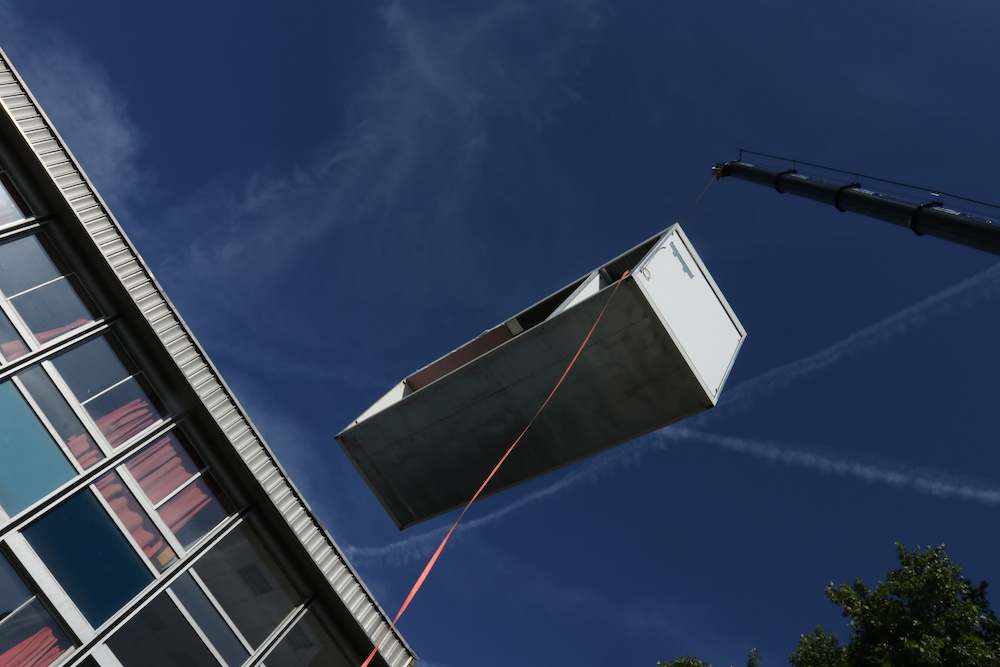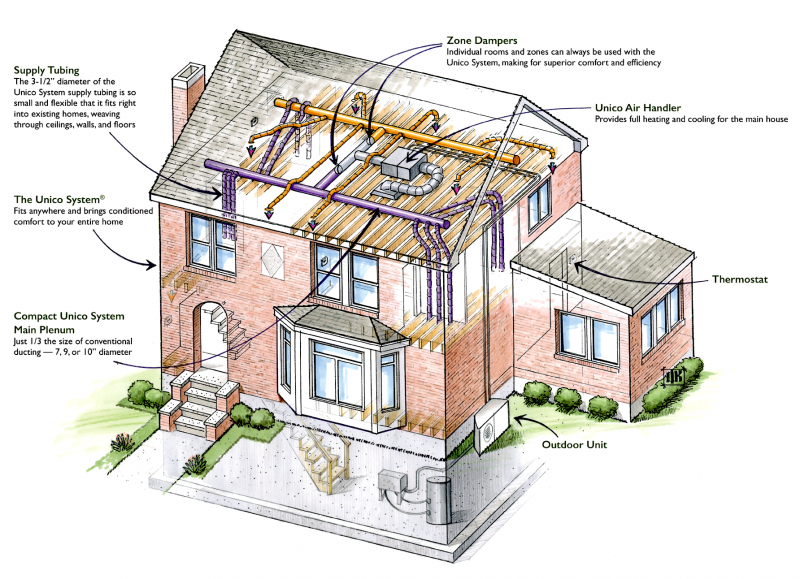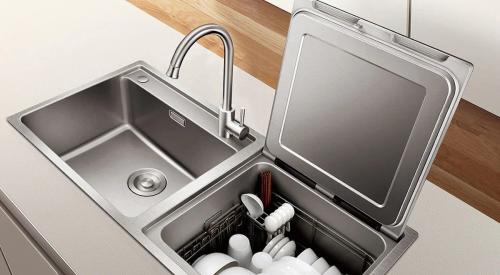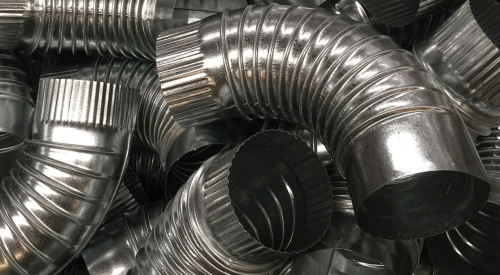Modular housing has come a long way since the first double-section off-site constructed home built to a local housing code appeared in 1958. Heating, ventilation, and air conditioning (HVAC) technology has also made great strides in energy efficiency, indoor air quality (IAQ), and indoor comfort in the past 60 years. Modular homemakers, builders, and owners now have many choices when it comes to indoor climate systems, but small-duct high-velocity (SDHV) systems may be the perfect fit for these types of homes. This article will examine how the design aspects of SDHV systems are particularly well-suited to modular homes.
As the name indicates, small-duct high-velocity HVAC uses a smaller duct system than traditional forced air systems. Because smaller ducting results in reduced air volume, it must deliver that air at a greater speed. SDHV systems operate under higher static pressure than conventional systems, with an average of 1.5-inches water column, and deliver air at a speed of 1,000 to 2,000 feet per minute (FPM) at each terminating register, called an outlet. This air delivery method relies on aspiration rather than traditional HVAC’s “dump and throw” approach. It has its own advantages in terms of energy efficiency and end-user comfort.
An SDHV System's Composition
SDHV systems are made up of the following components:
The air handling unit (AHU) — typically consists of a blower, a cooling coil, and/or heat pump coil. In those parts of the country where boilers are used as the primary heat source, a hot water coil is often substituted for the heat pump coil to provide central heating. These separate components, or modules, can be connected vertically or horizontally. SDHV AHUs are smaller than their traditional counterparts and fit into much tighter spaces.
Main duct, or plenum — SDHV plenum can come in the following sizing and constructions: insulated round (7-inch or 9-inch inner diameter), low-profile rectangular (3.5-inches high by 14.5-inches wide), or square (6.5-inch by 6.5-inch) sheet metal or pre-formed fiberglass. Because the SDHV main supply plenum is ¼ the size of a similarly sized large duct system, 12 tons of SDHV can fit in the same physical space as 3 tons of a conventional AC system.
Supply duct or tubing — SDHV systems use flexible supply tubing with a 4-inch OD and a 2-inch ID core for air delivery. These connect to the main plenum and weave through the smallest of cavities in the host structure, delivering air to various rooms.
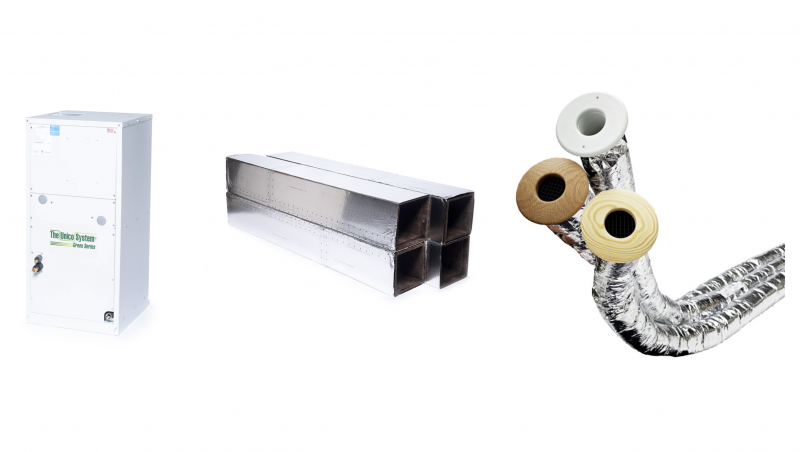
From left to right: Examples of a Unico air handler, plenum, and supply duct.
Image courtesy Unico
Terminating registers or outlets — Unlike the rectangular registers used by conventional HVAC, SDHV systems terminate in round (5-inch OD, 2-inch ID) or slotted (9-inch by 1-inch outer dimensions with a .5-inch by 7-inch inner opening). These outlets can be situated in walls, ceilings, or floors, come in various finishes and constructions, and can be painted, stained, or wallpapered to match any décor.
Return air system — The only aspect that SDHV shares with a conventional system is the fact that its return air side can be either singular or multiple by room.
Outdoor unit — While some SDHV manufacturers do offer outdoor units, most often varying types of heat pumps, most SDHV systems are compatible with major manufactured brands of outdoor compressors, condensers, chillers, and heat pumps (air, water, or geothermal). This provides builders, subcontractors, and end users with control over their preferred method.
SDHV Compared With Conventional Systems
SDHV systems offer end users many benefits over their conventional counterparts when it comes to home design and aesthetics, comfort, energy efficiency, and indoor air quality, namely:
- SDHV components take up far less physical space than traditional HVAC systems, eliminating the need for bulwarks, soffits, and other duct concealments. Consequently, the aesthetic impact on the home is minimal, and the system virtually disappears into its décor.
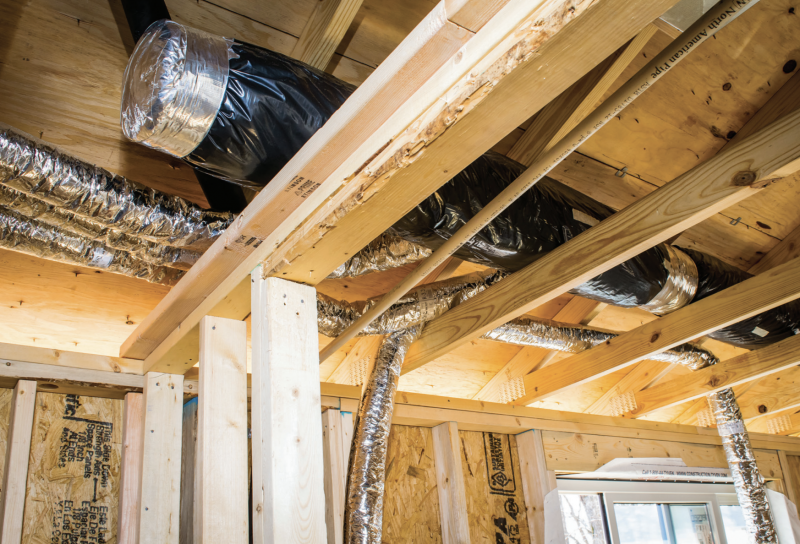
The above image is from a custom home case study and shows an air handling unit that's been installed above the ceiling of the home's top floor bedroom.
Image courtesy Unico
- SDHV cooling and heat pump coils are two times the thickness of traditional HVAC coils. This means they remove more moisture (i.e., relative humidity) in cooling mode and produce hotter temperatures in heating mode. Therefore, occupants are more comfortable at higher thermostat settings in the summer and lower thermostat settings in the winter, significantly reducing energy usage in both seasons.
- Independent studies have demonstrated that an SDHV system with a 14 SEER consumed 22% less energy than a conventional 22 SEER system. Additionally, due to its tight duct construction and smaller surface area, SDHV systems have virtually zero leakage and thermal loss of less than 3% capacity. By comparison, a traditional HVAC system with four times more surface area typically experiences thermal losses upwards of 10% of capacity.
- SDHV’s humidity removal not only boosts efficiency and overall comfort but also reduces mold growth risks and other allergens’ issues. Also, the tight nature of the ductwork greatly reduces the introduction of hair, dust particles, or other allergens, and SDHV systems are compatible with most major IAQ add-ons, such as filters, purifiers, etc., for further air treatment.
- When installed properly, SDHV systems are quieter than their traditional counterparts. And the aspiration air delivery method employed by SDHV provides even temperatures from floor to ceiling, with no drafts or hot and cold spots.
Image courtesy Unico
Advantages of SDHV Systems in Modular Homes
SDHV systems offer particular advantages to manufacturers and builders of modular homes, as well. Those include:
- All sales and equipment logistics can be direct from the SDHV manufacturer to the modular home factory and job site, bypassing any existing distribution channels they may have. This removes markups at the distributor and contractor levels and establishes a one-to-one relationship between the two entities.
- Major SDHV makers should be able to provide the modular home factory with the critical requirements for system integration: appropriate heating and cooling load calculations for proper sizing of the indoor comfort system; a system duct design with AHU placement, plenum, and supply layouts; and a material list for all needed equipment. They should also be able to provide in-factory installation assistance, at least for initial projects and until a standardized process is established.
- The smaller, modular components of SDHV systems mean they can easily be integrated into the structural components at a home manufacturer’s factory. In many modular applications, the low-profile duct (3.5 inches by 14.5 inches) can be installed in the interstitial space between modules to supply conditioned air to each module above and below the duct.
- The SDHV maker should also be available onsite for final supply duct and outlet hookups, installation of outdoor equipment, and commissioning to ensure a system is operating properly. Onsite, when the second-floor module is set atop the first floor, connecting the SDHV outlets should take a single, properly trained laborer less than an hour.
- A mutual relationship with an SDHV manufacturer allows modular home sellers to offer their clientele a complete home package that can be sold at a higher premium than their product lines that leave the HVAC system to the builder, their subcontractors, or the end-user themselves.
The design features that make SDHV systems so attractive for retrofitting older or historically significant homes built before the advent of modern central air systems or custom-built homes whose design elements and aesthetics would be significantly impacted by traditional ductwork are ideally suited to the modular home process and can be a win-win for both manufacturers.
Ashton Gavelek is the marketing brand manager for Unico, maker of The Unico System small-duct high-velocity HVAC system. Established in 1985, the manufacturer is a NAHB Building Systems Council member.
